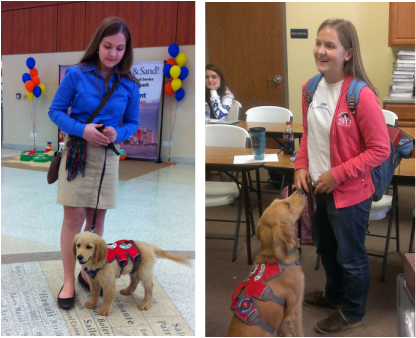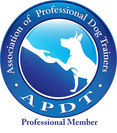
Providence brought me my biggest challenge in the form of a telephone repairman. Seeing my canine agility equipment and trophies, the repairman, Joe, asked if I knew about Diabetic Alert Dogs (DADs) - dogs that alert to high and low blood sugar. While I had always wanted to train a DAD, I lacked some basics, like knowledge and a client. Many emails later, I met with Joe and his wife, Regina. They shared with me how fear causes them to stand in the doorway each morning watching for the rise and fall of their daughter’s chest, hoping her blood sugar hadn’t plummeted during the night. They needed help for their daughter, Mackenzie, and they were asking me for it.
Armed with the assignment of creating a DAD, I spent Christmas break immersed in blogs and websites about diabetes and alert dogs. Unfortunately, information on this subject is either incomplete or, worse, contradictory. As a result, I had to develop my own protocol. All the sources did agree that DADs need to be trained using the saliva of a diabetic; meaning I had to spend quality time with Mackenzie's spit.
We found an upcoming litter whose breeder allowed me to raise the pups in my home – what turned out to be an exhausting experience! Within 24 hours of the pups’ birth, I began imprinting them by spraying the mother’s nipples with a solution made from a low blood sugar swab of Mackenzie’s saliva. I then put the puppies on to nurse, thus associating low blood sugar scent with food. At three weeks, I began putting the swab sample in front of the pups’ noses, rewarding them with treats if they moved towards the scent, and recording which ones understood the concept.
By the time the pups were five weeks old, I had eliminated the six puppies that seemed oblivious to the training. From the remaining three, I chose the pup with the best temperament. Over the next few months I focused on teaching the pup - now named Sadie - obedience and we played hide and seek with the low sugar samples. As Sadie gained confidence recognizing the scent, I began to wait for her to paw the sample in frustration before rewarding her, since eventually she would need to paw the person whose blood sugar is off. To proof her training, I added distractions and moved to putting the swab on a person. By four months, Sadie was live-alerting me if I skipped breakfast, meaning she was alerting to my blood sugar if it dropped below 80 mg/dL. I then realized this might work!
Sadie now attends school with me and alerts to my diabetic classmates’ blood sugar extremes daily. She and I have been inseparable since her birth, eight months ago, but in a few weeks she will go to Mackenzie permanently. While I know that this is exactly what I trained her for, and that her presence will extend Mackenzie’s life, I can’t help but feel that I am losing my best friend.
Armed with the assignment of creating a DAD, I spent Christmas break immersed in blogs and websites about diabetes and alert dogs. Unfortunately, information on this subject is either incomplete or, worse, contradictory. As a result, I had to develop my own protocol. All the sources did agree that DADs need to be trained using the saliva of a diabetic; meaning I had to spend quality time with Mackenzie's spit.
We found an upcoming litter whose breeder allowed me to raise the pups in my home – what turned out to be an exhausting experience! Within 24 hours of the pups’ birth, I began imprinting them by spraying the mother’s nipples with a solution made from a low blood sugar swab of Mackenzie’s saliva. I then put the puppies on to nurse, thus associating low blood sugar scent with food. At three weeks, I began putting the swab sample in front of the pups’ noses, rewarding them with treats if they moved towards the scent, and recording which ones understood the concept.
By the time the pups were five weeks old, I had eliminated the six puppies that seemed oblivious to the training. From the remaining three, I chose the pup with the best temperament. Over the next few months I focused on teaching the pup - now named Sadie - obedience and we played hide and seek with the low sugar samples. As Sadie gained confidence recognizing the scent, I began to wait for her to paw the sample in frustration before rewarding her, since eventually she would need to paw the person whose blood sugar is off. To proof her training, I added distractions and moved to putting the swab on a person. By four months, Sadie was live-alerting me if I skipped breakfast, meaning she was alerting to my blood sugar if it dropped below 80 mg/dL. I then realized this might work!
Sadie now attends school with me and alerts to my diabetic classmates’ blood sugar extremes daily. She and I have been inseparable since her birth, eight months ago, but in a few weeks she will go to Mackenzie permanently. While I know that this is exactly what I trained her for, and that her presence will extend Mackenzie’s life, I can’t help but feel that I am losing my best friend.

